Football takes on a whole new dimension at Peru’s Estadio Daniel Alcides Carrion. At a breathtaking 14,232 feet above sea level, this venue stands as the world’s highest stadium – a place where even the simple act of breathing becomes a formidable challenge for visiting players.
What makes South America truly remarkable in the world of sports? The continent exclusively hosts all ten of the planet’s highest professional football stadiums. From Peru to Bolivia and Colombia, these elevated arenas create unparalleled challenges for athletes while offering spectators experiences they simply can’t find anywhere else.
These sky-high venues haven’t existed without controversy. FIFA famously attempted to ban matches above 8,200 feet in 2007, citing player safety and competitive fairness. The restriction sparked immediate backlash from South American nations and was eventually reversed, preserving these unique sporting theaters.
Are you ready to discover Top 10 Highest Stadium in the World where the air is thinner than on most mountain peaks? Join us as we explore these architectural marvels that push human performance to its absolute limits and showcase South America’s distinctive contribution to the beautiful game.
Table of Contents
Top 10 Highest Stadium in the World: Where Football Meets the Sky
Estadio Daniel Alcides Carrion (Peru) – The World’s Highest Stadium at 14,232 ft
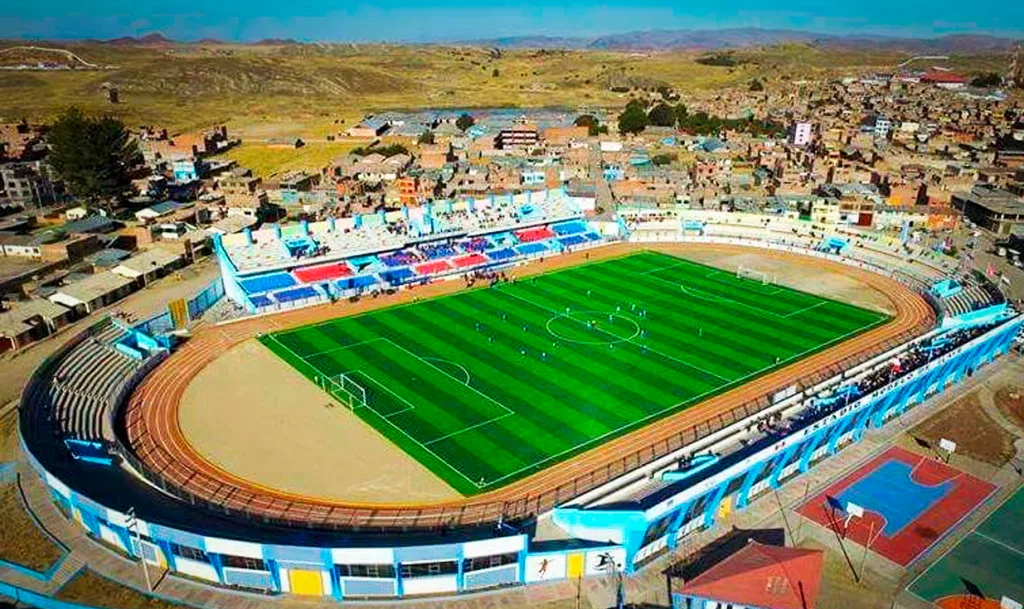
Perched in the Peruvian city of Cerro de Pasco sits a true engineering marvel that pushes the boundaries of human endurance. Estadio Daniel Alcides Carrion towers at an astonishing 14,232 feet (4,338 meters) above sea level, making it officially the highest stadium in the world. To put this extreme elevation into perspective, you’d need to stack more than 14 Shard buildings on top of each other to reach this height from sea level.
History and Construction of Estadio Daniel Alcides Carrion
The stadium’s story begins in the 1960s, when it was built with a modest capacity of 8,000 spectators. Named after a Peruvian medical student who became the namesake of Carrion’s Disease, this venue has long served as home ground for local clubs Unión Minas and Ecosem Pasco.
The stadium underwent a significant transformation in 2012, receiving upgrades to match its iconic status. One of the most notable changes? Natural grass gave way to synthetic turf – a practical necessity given that traditional grass simply struggles to thrive at such extreme altitudes. The renovation also boosted seating capacity from 8,000 to 12,000, though some sources continue to list the lower figure.
Playing Conditions at Extreme Altitude
What happens when elite athletes compete nearly three miles above sea level? The physiological challenges are extraordinary. At Estadio Daniel Alcides Carrion, the severely reduced oxygen levels create a perfect storm of difficulties:
- Players experience crushing fatigue before half-time even begins
- Heart rates and blood pressure skyrocket to compensate for oxygen scarcity
- Recovery between sprints becomes painfully slow and inadequate
- Athletes face genuine risks of altitude illness including mountain sickness
These conditions have earned the venue a reputation as perhaps the most dreaded away fixture in world football. The oxygen shortage is so severe that players sometimes require bottled oxygen during matches. FIFA doesn’t take these challenges lightly, recommending a full 10-day acclimatization period for visiting teams competing above 3,000 meters.
Notable Matches and Events
The stadium witnessed its most historic moment on June 25, 2000, when Universitario de Deportes traveled from Lima to defeat home side Unión Minas 2-1. This crucial victory secured Universitario both the Torneo Apertura title and eventually the 2000 Torneo Descentralizado championship.
International controversy engulfed the venue during FIFA’s 2007 decision to ban matches above 8,200 feet (2,500 meters). Football’s governing body pointed to concerns about competitive fairness and player health. The ban sparked immediate outrage across South America, particularly affecting Bolivia, Ecuador, and Colombia, who suddenly couldn’t host World Cup qualifiers in their capital cities. Following passionate protests – including one led by Argentine legend Diego Maradona – FIFA ultimately reversed the ban in May 2008.
Visitor Experience and Tourism Impact
Despite its challenging conditions, the stadium offers visitors a truly unique experience. Set against the spectacular backdrop of the Andean mountains, the views from Estadio Daniel Alcides Carrion enhance Cerro de Pasco’s tourism appeal.
Today, the venue mainly hosts Copa Perú matches and Liga Departamental Pasco fixtures. International games remain rare, with just a handful of Peru Cup matches played yearly. This limited international schedule allows visiting teams adequate time to adjust to the extreme conditions.
Tourism represents Peru’s third-largest industry after fishing and mining, contributing 7% to the nation’s GDP. While Estadio Daniel Alcides Carrion doesn’t draw tourist numbers comparable to Peru’s archaeological treasures or colonial cities, it stands as a fascinating sporting landmark that adds another dimension to the country’s diverse attractions.
Estadio de Villa Ingenio (Bolivia) – 13,392 ft Above Sea Level

Bolivia’s Estadio Municipal de Villa Ingenio stands as the second-highest football arena on the planet, soaring at a staggering 13,392 feet (4,090 meters) above sea level. Located in El Alto—recognized as the highest major city worldwide with an average elevation of 4,150 meters—this sky-high venue has transformed into both an impenetrable fortress for home teams and a nightmare for visiting opponents.
Architectural Features of Villa Ingenio
The stadium opened its doors on July 16, 2017, representing Bolivia’s most ambitious sporting infrastructure project in decades. The government poured 55.8 million bolivianos (roughly 6.6 million euros) into its construction, creating a 25,000-seat colossus with distinctive blue trim that makes the green pitch pop dramatically against El Alto’s arid landscape.
What makes this venue truly special from an engineering perspective? Villa Ingenio initially featured the world’s highest-altitude FIFA Quality Pro certified synthetic turf. The stadium pioneered Bolivia’s first horizontal drainage system, employing a ProPlay®-Sport23D shock pad with remarkable water management capabilities. These innovations earned the venue recognition as “the first modern stadium in Bolivia”, setting new benchmarks for sports facilities across the country.
Home Teams and Local Football Culture
Two Bolivian clubs call this oxygen-starved arena home: Always Ready and Club Deportivo FATIC. Always Ready has particularly mastered the altitude advantage, securing Conmebol’s approval to host Copa Libertadores matches here in 2023—a major breakthrough for Bolivian football.
The home field advantage at Villa Ingenio isn’t just significant—it’s overwhelming. Local teams remain undefeated in international competitions like Copa Libertadores and Sudamericana when playing here. This stark home-away performance gap mirrors Bolivia’s national team pattern, which has managed just one competitive victory outside Bolivia in nearly three decades.
“4150 MTS ALT. SE JUEGA DONDE SE VIVE” (“We play where we live”)—this defiant slogan captures the essence of Villa Ingenio’s football culture. The stadium has even served as a testing ground for Bolivia’s national team, with 80% of the squad drawn from Always Ready and Bolívar players already adapted to these extreme conditions.
Altitude Challenges for Visiting Teams
What happens when teams from sea level face the thin air of Villa Ingenio? The physiological challenges are brutal and immediate:
- Players experience crushing fatigue with dramatically impaired recovery
- Heart and breathing rates skyrocket as bodies desperately seek oxygen
- Sprint capacity plummets alongside noticeably slower reaction times
- Many suffer altitude sickness with nausea, headaches and vomiting
Even the ball behaves differently here—traveling faster while curving less. After a match in La Paz (which sits 560 meters lower than El Alto!), Brazilian superstar Neymar famously required oxygen masks during recovery.
Visiting teams try everything from specialized breathing exercises to acclimatization in hyperbaric chambers, yet the advantage remains enormous. When Sporting Cristal from Lima (just 150 meters above sea level) played here, their coach Enderson Moreira admitted the stark reality: “playing at this altitude is very difficult… the behavior of the players is completely different”.
Recent Renovations and Improvements
Villa Ingenio underwent major renovations in 2023 to meet Conmebol’s stringent international competition standards. The upgrades included:
- A challenging transition from synthetic turf to natural grass—no small feat at an altitude where vegetation struggles to survive
- Installation of cutting-edge lighting systems for night matches
- Expanded seating sections for spectators
- Comprehensive infrastructure improvements to surrounding roads, parking areas, and player access tunnels
These substantial investments have elevated Villa Ingenio into a venue worthy of the international spotlight. The stadium recently received an additional upgrade with new seating, further enhancing comfort for fans brave enough to watch football in the Andean stratosphere.
Estadio Victor Augustin Ugarte (Bolivia) – 12,795 ft of Breathtaking Height
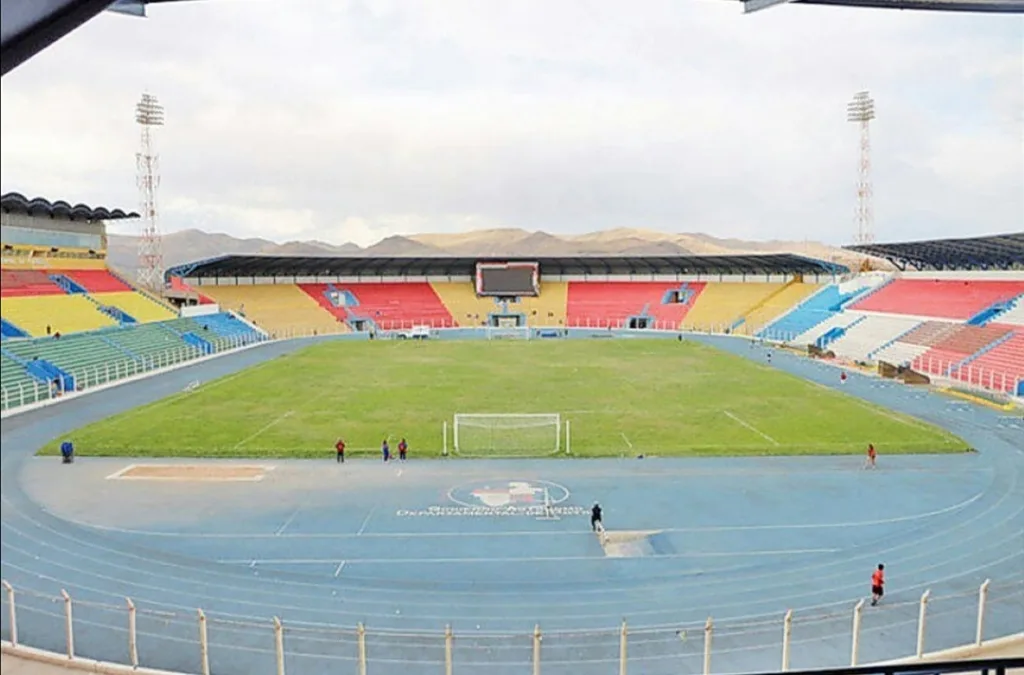
Bolivia strikes again with another oxygen-starved football marvel! Rising from the historic silver mining city of Potosí, Estadio Víctor Agustín Ugarte sits at a jaw-dropping 12,795 feet (3,900 meters) above sea level. As the third highest professional football stadium on our list, this venue transforms every match into a battle against nature for visiting teams while offering spectators one of the most extraordinary sporting environments you’ll find anywhere on earth.
The Story Behind Victor Augustin Ugarte
Who was the man behind this stadium’s name? The imposing venue honors one of Bolivia’s football legends, Víctor Agustín Ugarte, a celebrated player whose contributions to Bolivian football left an indelible mark on the nation’s sporting history. The stadium’s identity has evolved significantly over time. Initially opened in 1992 as Estadio San Clemente, it later became Estadio Mario Mercado Vaca Guzmán following upgrades that included new illumination towers. The current name didn’t come about until 2007, established through official government legislation (Law No. 3435) passed on July 11, 2006 – a testament to Ugarte’s towering status in Bolivian football culture.
Stadium Design and Capacity
What makes this venue stand out architecturally? The stadium features a versatile multi-purpose design though primarily hosts football matches. Its expansion story reflects Bolivia’s growing football ambitions. The first major renovation in 1997 added two new sections (general and north curve), boosting capacity to 13,000 spectators. The real transformation came in 2008 when the stadium nearly tripled in size to accommodate international competitions.
Today, the venue welcomes 32,000 fans according to most reliable sources. Some references suggest it might hold even more – up to 35,000 spectators. Perhaps its most distinctive architectural feature came during the 2008 renovation: a roof spanning the entire stadium perimeter, providing protection from Potosí’s intense mountain sun and occasional downpours.
The stadium serves as home to two Bolivian clubs – Real Potosí and Nacional Potosí. Beyond football, it occasionally hosts athletics competitions, cementing its status as a true multi-purpose venue in the breathtaking Bolivian highlands.
Major Tournaments Hosted
The stadium catapulted to international prominence in 2002 when Real Potosí qualified for their first-ever Copa Libertadores appearance. Meeting CONMEBOL’s stringent requirements for this prestigious tournament demanded serious investment – approximately $3.5 million poured into modernizing the stadium’s infrastructure and services.
Have you ever wondered what makes playing here so challenging? The altitude factor at Estadio Víctor Agustín Ugarte has sparked heated debates among football purists. At roughly 4,000 meters above sea level, it ranks among the world’s highest competitive sports venues. This extreme elevation dramatically impacts oxygen absorption, creating what many consider an overwhelming advantage for home teams accustomed to these thin-air conditions.
Despite the controversy that led to FIFA’s temporary 2007 ban on matches above 2,500 meters, venues like Víctor Agustín Ugarte continue hosting elite competitions today. This unique challenge has become part of what makes Bolivian football unlike anything else you’ll experience in the global game.
Estadio Enrique Torres Bolen (Peru) – 12,562 ft Stone Marvel
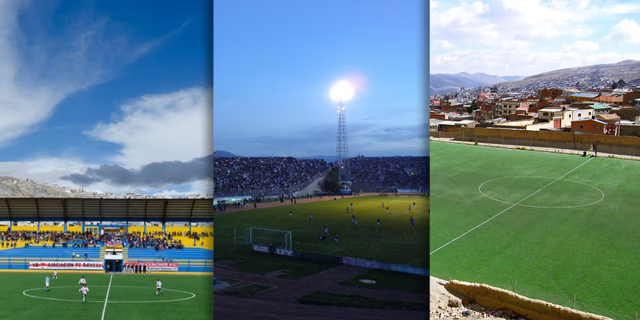
Peru’s Estadio Enrique Torres Belon stands as a true anomaly in the world of modern sports architecture. Rising 12,562 feet (3,829 meters) above sea level, this stone colossus ranks fourth on our list of the planet’s highest stadiums. What sets this venue apart from every other stadium we’ve explored? Unlike its concrete competitors, this architectural wonder captivates visitors with its extraordinary construction materials and breathtaking natural setting.
Unique Stone Construction
The stadium’s most distinctive feature must be its remarkable stone architecture. Engineers built the entire structure using stones, embracing traditional Andean construction techniques that date back centuries. This approach pays homage to ancient Peruvian building methods where skilled artisans positioned large stones in intricate interlocking patterns without mortar or binding agents. The stadium walls showcase exceptional craftsmanship – each stone element fits precisely with its neighbors, creating a stable, enduring structure that has weathered decades of harsh high-altitude conditions.
Stone construction delivers practical advantages beyond its stunning visual appeal. The natural materials provide excellent thermal regulation – a crucial benefit given the dramatic temperature swings common at these elevations. The stone walls also create superior acoustics, amplifying crowd noise during matches and generating an intimidating atmosphere that visiting teams find difficult to overcome.
Location Near Lake Titicaca
The stadium’s setting plays a major role in its unique character. Located in Puno, Peru near the shores of Lake Titicaca, it occupies one of South America’s most visually spectacular regions. Lake Titicaca itself holds an impressive distinction as the world’s highest navigable lake, sitting at 12,507 feet (3,812 meters) above sea level. This massive freshwater body spans the Peru-Bolivia border, covering roughly 3,200 square miles (8,300 square kilometers).
Proximity to Lake Titicaca rewards spectators with stunning panoramic views but creates additional challenges for athletes. Players must battle not only the thin mountain air but also lake-effect weather patterns that can produce unpredictable and rapidly changing conditions throughout matches.
Historical Significance in Peruvian Football
This stone giant first opened its doors in 1963, named after Enrique Torres Belon, a former Peruvian senator and regional advocate. With a capacity of 20,000 spectators, the stadium serves as home to local club Alfonso Ugarte, whose players enjoy perhaps the most distinctive home-field advantage in Peruvian football thanks to their adaptation to the extreme altitude.
The stadium’s importance transcends sports, representing Peru’s commitment to developing athletic infrastructure in highland regions traditionally overlooked by major facility investments. Its location near ancient Andean archaeological sites creates a fascinating bridge between modern sporting events and the region’s rich cultural heritage. Matches here deliver more than just football – they offer a unique cultural experience that draws both dedicated sports fans and tourists exploring the magical Lake Titicaca region.
Estadio Guillermo Briceno (Peru) – 12,545 ft Andean Giant

Peru delivers another high-altitude masterpiece with Estadio Guillermo Briceño Rosamedina! Located in the bustling city of Juliaca, this Andean giant rises an astounding 12,545 feet (3,825 meters) into the thin mountain air. Ranking fifth on our countdown of the world’s highest stadiums, this venue turns every match into a brutal test of endurance for visiting teams who dare to compete in these oxygen-starved conditions.
Juliaca’s Football Pride
The stadium’s journey began in 1966 when it first welcomed fans with a modest capacity of around 15,000 spectators. Local officials clearly recognized its potential, announcing ambitious expansion plans in 2016. Though construction faced delays, work finally kicked off in 2020 and reached completion in 2021. Today, the renovated venue accommodates 20,030 passionate fans, establishing it among Peru’s more substantial football facilities.
What makes this stadium truly special beyond its altitude? Many consider it one of Peru’s most visually striking sporting venues. The seats feature a distinctive color pattern that pays homage to traditional Quechua textile designs, drawing inspiration from similar artistic elements found at Cusco’s Estadio Garcilaso. This thoughtful design choice creates a beautiful bridge between Peru’s ancient cultural heritage and its modern sporting ambitions.
Weather Conditions and Playing Challenges
The extreme elevation of Juliaca creates weather conditions that dramatically impact every aspect of match play. Daytime temperatures hover around a comfortable 62°F, but when the sun sets, the mercury plummets to a bone-chilling 25°F. The sun’s intensity at this altitude is particularly brutal – spectators and players alike must arm themselves with hats, sunglasses, and heavy-duty sunscreen just to endure a full match.
For players, the oxygen scarcity at 12,545 feet creates a perfect storm of physiological challenges:
- Stamina evaporates as fatigue sets in with alarming speed
- Simply breathing becomes a conscious effort during high-intensity sequences
- Recovery between sprints stretches from seconds to seemingly endless minutes
- The constant specter of altitude sickness symptoms looms over every visiting player
Local Team Performance Advantage
Deportivo Binacional called this challenging venue home until their relegation to the Peruvian Segunda División in 2023. Their years of adaptation to these unique conditions granted them a formidable advantage that visiting teams simply couldn’t match.
The home-field advantage at this altitude isn’t just significant – it’s game-changing. Teams accustomed to these conditions develop critical physiological adaptations including increased red blood cell production and enhanced oxygen utilization. These biological advantages only come through months or years of exposure to high-altitude environments.
Visiting teams face an immediate shock when the ball behaves in ways they’ve never experienced – flying faster through the thin air with reduced resistance affecting both trajectory and control. At Estadio Guillermo Briceño, altitude becomes a silent twelfth man, an invisible opponent just as formidable as the team on the opposite side of the pitch.
Estadio Jesus Bermudez (Bolivia) – 12,253 ft Oruro Landmark
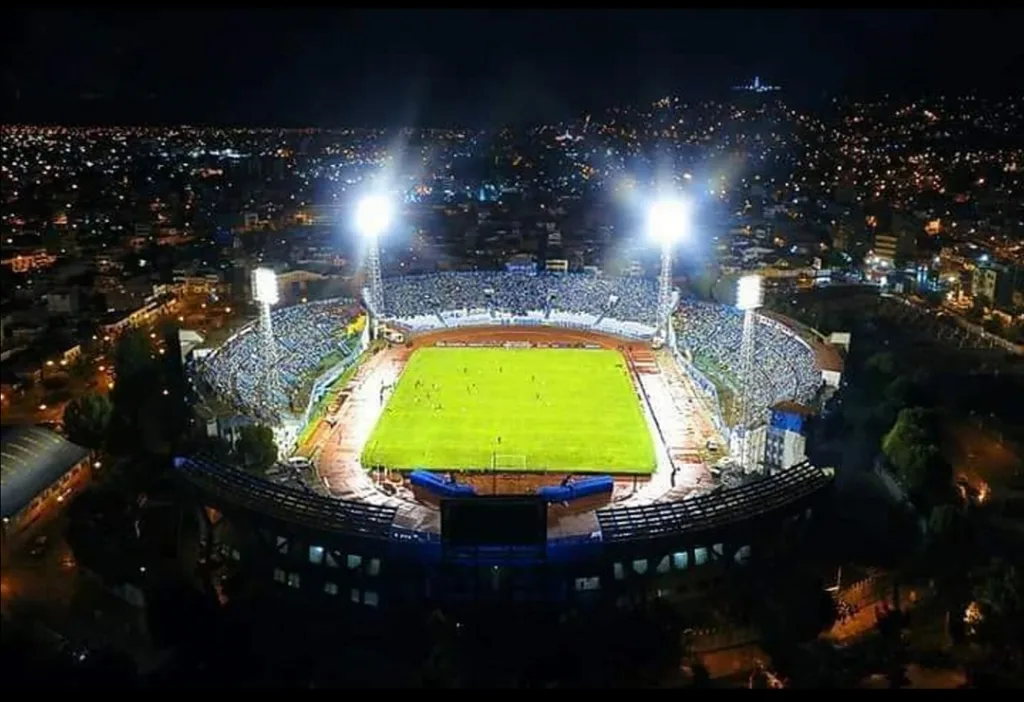
Named after Bolivia’s first-ever national team goalkeeper, Estadio Jesús Bermúdez towers at an impressive 12,253 feet (3,735 meters) above sea level in the historic mining city of Oruro, Bolivia . This multi-purpose giant, inaugurated in 1955 , primarily hosts football matches and athletics competitions while serving as home to Club San José and several other local teams .
Copa America Matches at High Altitude
The stadium boasts a rich tournament history that few South American venues can match. Estadio Jesús Bermúdez notably hosted two critical group stage matches during the 1975 Copa América , a tournament that stands as Bolivia’s crowning achievement in international football. The hosts leveraged their high-altitude advantage masterfully, remaining undefeated throughout the competition to secure their only international title .
The venue further cemented its continental significance when it hosted the prestigious third-place match of the 1997 Copa América . These high-profile fixtures showcased the unique challenges visiting teams face in Bolivia’s thin atmosphere, where players routinely suffer headaches, dizziness, confusion, and severe dehydration – transforming football matches into battles against both opponents and nature .
Stadium Facilities and Amenities
Architecturally, the stadium features traditional concrete terraces wrapped around a versatile main pitch designed to accommodate both football and athletics . Capacity reports vary significantly between sources, ranging from 30,000 to as high as 40,000 , though most reliable assessments place the actual figure between 33,000-35,000 spectators .
The technical specifications tell the story of a classic South American sporting venue:
- Pitch dimensions stretch to 110m x 70m
- A full running track encircles the playing surface
- Unlike some other high-altitude stadiums, construction relies primarily on concrete rather than natural materials
Altitude Training for Local Athletes
Bolivian athletes born and raised in Oruro enjoy remarkable physiological adaptations that create a substantial competitive edge. Recognizing this natural advantage, Oruro’s government launched the “Desarrollo del Atletismo de Alto Rendimiento” program specifically to develop high-altitude athletic talent .
The science behind this advantage is striking. Research from the Instituto Boliviano de Biología de Altura (IBBA) has documented that players from lower elevations experience an 18% drop in VO2max within just 6 hours of arriving in La Paz – and La Paz sits nearly 500m lower than Oruro! This disadvantage worsens to a staggering 24% after 72 hours .
Visiting teams have tried everything to counter these effects. Some arrive just hours before kickoff to exploit what Bolivian football officials call a “physiological window” . Others turn to coca leaf tea or hyperbaric chambers, though these approaches have shown limited success against the overwhelming altitude advantage .
Football at Estadio Jesús Bermúdez isn’t just a game – it’s a physiological battle where local players wield perhaps the most significant home-field advantage in global sports.
Estadio Hernando Siles (Bolivia) – 11,824 ft La Paz Icon
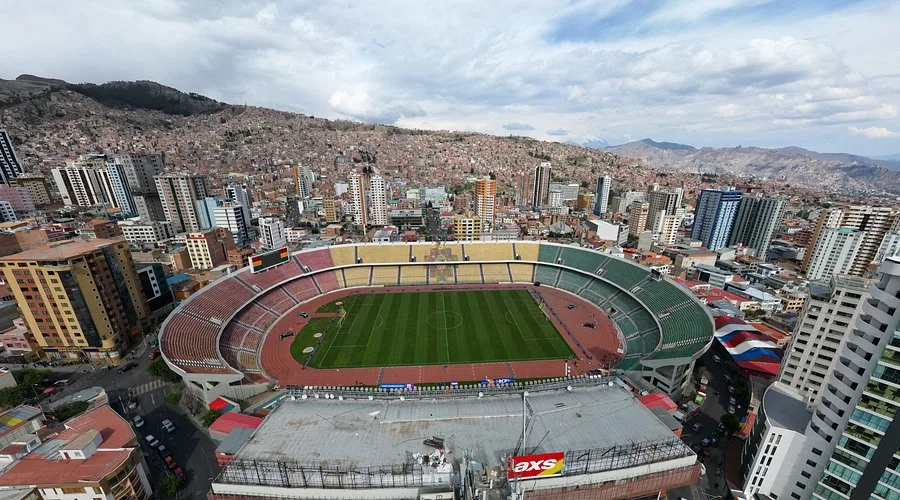
Bolivia’s legendary Estadio Hernando Siles doesn’t just host football matches – it sparked a global sporting controversy that reached presidential levels. Constructed in 1931 in La Paz’s Miraflores borough, this concrete colosseum sits at a breathtaking 11,824 feet (3,637 meters) above sea level, bearing the name of Bolivia’s 31st president who served from 1926-1930. With 41,143 seats, this venue represents something far more profound than a simple stadium – it symbolizes a nation’s successful fight against international sporting regulations that threatened their football identity.
Bolivia’s National Team Home
The numbers tell a remarkable story about home advantage at extreme altitude. As Bolivia’s premier sports complex, this iconic venue hosts the national team in what has become one of world football’s most intimidating environments. Need proof? Throughout four World Cup qualifying campaigns (2006, 2010, 2014, and 2018), Bolivia racked up fourteen home wins and ten home draws, while managing just two away draws and zero away victories. Could there be a more compelling demonstration of how altitude transforms sporting competition?
FIFA Altitude Controversy
May 2007 marked a turning point in South American football when FIFA stunned the continent by banning international matches above 8,200 feet (2,500 meters). Football’s governing body cited player health concerns and “unfair” advantages for high-altitude teams – a ruling that prevented Bolivia, Ecuador, and Colombia from hosting World Cup qualifiers in their capital cities.
The reaction was swift and fierce. Bolivian President Evo Morales labeled the decision “football apartheid” and personally led a campaign emphasizing that football should be played wherever people live – mountain or valley, sea level or stratosphere.
Famous Upsets Against Lowland Teams
Hernando Siles Stadium has witnessed some of football’s most shocking results. Argentina’s 6-1 humiliation in April 2009 stands as their worst defeat in 60 years. Even mighty Brazil wasn’t immune, falling 2-0 in 1993 – their first World Cup qualifier loss in four decades.
The physical toll on visiting superstars is evident after every match. Post-game images of Brazil’s Neymar and Argentina’s Lionel Messi using oxygen masks have become iconic symbols of La Paz’s challenging conditions.
Maradona’s Altitude Protest Match
Football history is filled with ironies, but few match Diego Maradona’s relationship with this stadium. The Argentine legend who later suffered that crushing 6-1 defeat as Argentina’s coach had previously been one of the most vocal defenders of Bolivia’s right to play at altitude.
In 2008, a 47-year-old Maradona joined a charity match at Hernando Siles, leading former Argentine stars to a 7-4 victory against President Morales’ team. His post-match declaration became a rallying cry: “You have the right to play where you were born. That cannot be decided neither by God nor much less by Blatter”.
FIFA ultimately reversed their controversial ban in May 2008, preserving Estadio Hernando Siles’ rightful place in world football and ensuring Bolivia could continue competing where generations of its citizens have lived and played.
Estadio Inca Garcilaso de la Vega (Peru) – 11,079 ft Historical Venue
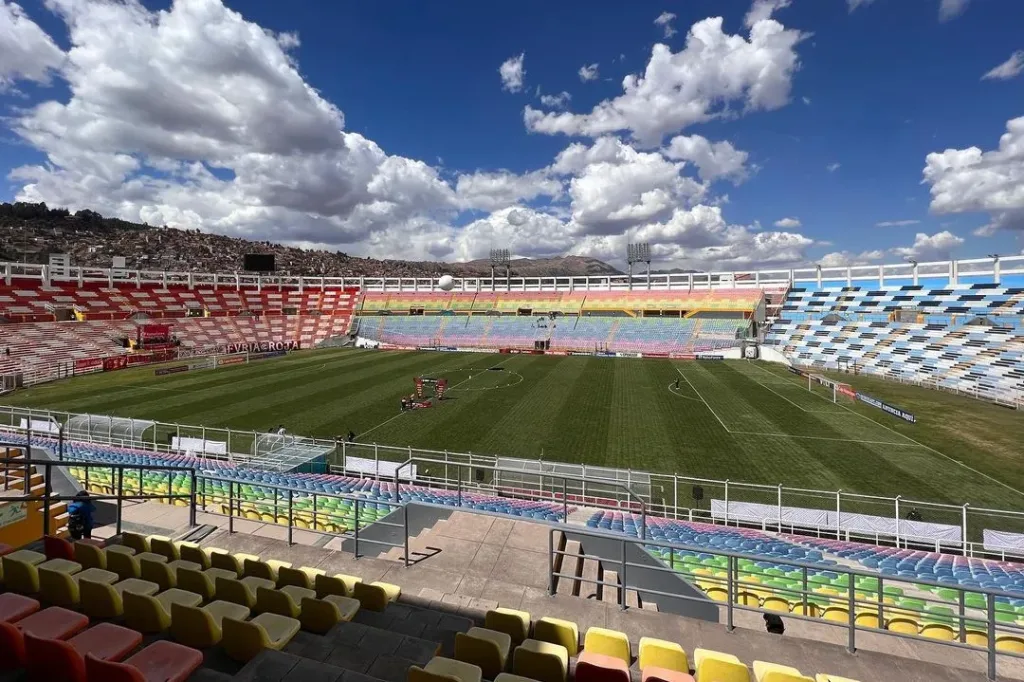
The ancient Inca capital of Cusco hosts one of football’s most culturally significant venues. Estadio Inca Garcilaso de la Vega stands proudly at 11,079 feet (3,377 meters) above sea level, securing its position as the eighth highest professional football stadium in the world. This remarkable facility blends rich cultural heritage with sporting excellence, creating an unforgettable destination where history and football passion collide.
Cusco’s Football Heritage
Known locally as Estadio Garcilaso, this iconic venue serves as home to an impressive three Primera División clubs: Cienciano, Deportivo Garcilaso, and Cusco FC. The stadium’s defining moment? A historic night in 2003 when Cienciano achieved what no Peruvian team had done before—winning an international competition by defeating Argentina’s powerhouse River Plate in the Copa Sudamericana final. This breakthrough victory forever etched both the stadium and Cusco into South American football lore.
Beyond this crowning achievement, the stadium has hosted a remarkable array of prestigious events including three Peruvian Primera División finals (2001, 2006, and 2012) and a memorable Copa Perú final in 2011. Its international pedigree continues to grow as the venue regularly welcomes continental competitions including both Copa Libertadores and Copa Sudamericana matches.
Stadium Expansion History
The stadium’s journey began in 1950 when it opened with a modest capacity of approximately 20,000 spectators. Everything changed with the approach of the 2004 Copa América, when the Peruvian government poured $5 million into comprehensive renovations. These improvements dramatically expanded the venue to its current capacity of 42,056-45,056 seats[361], transforming it into one of Peru’s premier sporting venues.
Ambition for further enhancement surfaced in 2013 with an impressive $52 million renovation proposal that would have increased capacity to 50,000 while adding luxury boxes and sun shades. Unfortunately, budget realities intervened, limiting actual improvements to a new entrance, some luxury boxes, seating upgrades, and exterior refinements.
Tourist Attraction Status
Football enthusiasts and architecture critics alike recognize this venue as one of South America’s most beautiful stadiums. Groundskeepers have achieved the seemingly impossible—maintaining exceptionally lush grass that thrives despite Cusco’s challenging and variable climate.
The stadium enjoys a prime location in Peru’s number one tourist destination, with excellent accessibility that puts it just a comfortable 15-20 minute stroll from Cusco’s historic Plaza de Armas.
Want to experience something truly special during your visit? Estadio Garcilaso made history as Peru’s first stadium equipped with intelligent LED lighting technology. Its 168 luminaires create spectacular pre-match and post-match light shows that transform ordinary games into unforgettable spectacles. This modern enhancement, combined with the venue’s profound historical significance, makes attending a match here an essential highlight for anyone exploring the former capital of the Inca Empire.
Estadio Huancayo (Peru) – 10,690 ft Multi-Purpose Arena
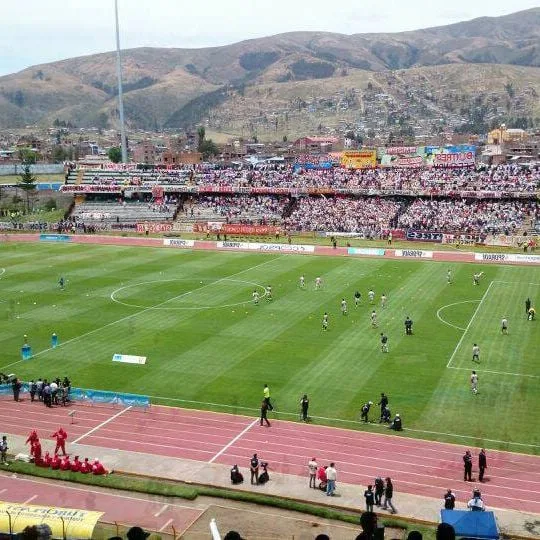
Peru makes another appearance on our list with Estadio Huancayo, constructed in 1962 and standing at an impressive 10,690 feet (3,259 meters) above sea level. This elevation secures its position as the ninth highest professional stadium in our global ranking. The 20,000-capacity venue primarily hosts Sport Huancayo and Deportivo Junín, while Deportivo Wanka and Meteor Junin have previously called these oxygen-starved grounds home.
Beyond Football: Other Uses
What sets Estadio Huancayo apart from many single-purpose venues? Its remarkable versatility. The stadium features a complete running track encircling the natural grass playing surface, allowing it to host athletics competitions throughout the year. This multi-functionality makes brilliant use of limited space, creating an exceptionally efficient facility for a region where sporting infrastructure isn’t abundant. Rather than building separate venues for different sports, this arena breaks down traditional barriers between athletic disciplines, welcoming diverse athletes and sports enthusiasts under one roof.
Altitude Effects on Different Sports
The effects of altitude aren’t uniform across all sporting activities at Estadio Huancayo. Endurance events take the hardest hit at these elevations, with research documenting a significant VO₂max decrease of 8-11% for every 1,000 meters of ascent. The oxygen scarcity primarily impacts aerobic performance, making recovery between intense efforts painfully slow for athletes unaccustomed to these conditions.
Surprisingly, high altitude isn’t always a disadvantage. Sprint performances either remain unaffected or actually improve thanks to decreased air resistance. You’ll also notice dramatic changes in ball physics at this elevation—footballs move significantly faster through the thinner air while experiencing reduced curve and drag. These unusual conditions create what coaches often describe as “playing a completely different sport”.
Local Economic Impact
The significance of Estadio Huancayo extends far beyond the final whistle of any match. Peru’s growing tourism sector contributes a substantial 3.9% to the nation’s GDP, with sporting venues playing an increasingly important role in attracting visitors. The tourism industry currently provides roughly 1.2 million direct jobs and 1.5 million indirect employment opportunities across the country.
Major sporting events hosted at the stadium bring valuable economic benefits to Huancayo, mirroring how tourism has become a crucial economic driver for regions traditionally dependent on agriculture. The venue serves a dual purpose—not just as an athletic facility but as a vital economic catalyst that energizes the surrounding community through job creation, increased visibility, and visitor spending.
Estadio El Campin (Colombia) – 10,660 ft Bogota Colossus

Rounding out our top ten highest stadiums countdown is Colombia’s legendary El Campín! Inaugurated on August 10, 1938, Estadio Nemesio Camacho El Campín rises 10,660 feet (3,250 meters) above sea level in the heart of Bogotá. This historic venue, often simply called “El Campín,” represents the final entry in our collection of the world’s most elevated football theaters, creating conditions that leave unprepared visitors gasping for breath.
Colombia’s Highest Capacity Stadium
El Campín’s evolution tells a fascinating story of Colombian football’s growing popularity. Starting with a modest 10,000 seats, the stadium underwent dramatic expansions reaching 54,000 capacity by 1951, before peaking at an impressive 62,500 in 1968. After several rounds of modernization, today’s venue accommodates between 39,512 and 40,312 spectators. The stadium serves as beloved home to two of Colombia’s most storied football institutions – Millonarios FC and Independiente Santa Fe.
Modern Facilities at High Altitude
What’s it like to watch a match at El Campín? You’ll enjoy excellent sightlines from practically any seat in the house! The current configuration features all the modern amenities you’d expect – dedicated media zones, multiple team dressing rooms, and state-of-the-art lighting systems. Interestingly, concerts were prohibited for several years to preserve the playing surface, but since 2012, musical performances have returned, establishing El Campín as Bogotá’s premier multi-purpose entertainment destination.
International Matches and Memorable Moments
El Campín’s crowning achievement undoubtedly came during the 2001 Copa América when the stadium hosted the tournament final between Colombia and Mexico. The home nation thrilled the packed crowd with a narrow 1-0 victory! The venue’s international pedigree grew further when it hosted the 2011 FIFA U-20 World Cup final, alongside numerous high-profile friendlies against football giants including England, Soviet Union, Spain, and Argentina.
Beyond the beautiful game, El Campín has welcomed some of music’s biggest names – Paul McCartney, The Rolling Stones, Lady Gaga, U2, and Coldplay have all performed beneath the Bogotá sky.
Future Development Plans
El Campín’s story isn’t finished – it’s about to begin an exciting new chapter! Bogotá’s city hall recently signed a contract for a massive 2.4 billion Peso renovation project that promises to transform this historic venue. The ambitious plans include:
- Boosting capacity to 46,500 passionate fans
- Installing a spectacular retractable roof
- Creating premium VIP areas and restaurant facilities
- Building dedicated locker rooms for the venue’s resident teams
- Constructing a special auditorium for the Bogotá Philharmonic Orchestra
When will all this happen? Construction is set to kick off in December 2025, with the grand unveiling expected approximately three-and-a-half years later. Football fans across Colombia can’t wait to see their iconic stadium reimagined for the future while preserving its storied past and breathtaking altitude!
Comparison Table: The World’s Highest Football Battlegrounds
Want a quick reference to compare all ten sky-high stadiums? This comprehensive breakdown highlights the key features that make each venue unique. From Peru’s oxygen-starved Estadio Daniel Alcides Carrion at over 14,000 feet to Colombia’s historic El Campin, these atmospheric arenas challenge players and delight fans in ways conventional stadiums simply can’t match.
| Stadium Name (Country) | Altitude | Capacity | Year Opened | Home Teams | Notable Features |
|---|---|---|---|---|---|
| Estadio Daniel Alcides Carrion (Peru) | 14,232 ft (4,338 m) | 12,000 | 1960s | Unión Minas, Ecosem Pasco | First synthetic turf replaced natural grass due to altitude |
| Estadio de Villa Ingenio (Bolivia) | 13,392 ft (4,090 m) | 25,000 | 2017 | Always Ready, Club Deportivo FATIC | First modern stadium in Bolivia with horizontal drainage system |
| Estadio Victor Augustin Ugarte (Bolivia) | 12,795 ft (3,900 m) | 32,000 | 1992 | Real Potosí, Nacional Potosí | Features roof spanning entire stadium perimeter |
| Estadio Enrique Torres Bolen (Peru) | 12,562 ft (3,829 m) | 20,000 | 1963 | Alfonso Ugarte | Unique all-stone construction near Lake Titicaca |
| Estadio Guillermo Briceno (Peru) | 12,545 ft (3,825 m) | 20,030 | 1966 | Deportivo Binacional | Features traditional Quechua textile design patterns |
| Estadio Jesus Bermudez (Bolivia) | 12,253 ft (3,735 m) | 33,000-35,000 | 1955 | Club San José | Hosted 1975 Copa América matches |
| Estadio Hernando Siles (Bolivia) | 11,824 ft (3,637 m) | 41,143 | 1931 | Bolivia National Team | Site of Bolivia’s famous 6-1 victory over Argentina |
| Estadio Inca Garcilaso de la Vega (Peru) | 11,079 ft (3,377 m) | 42,056-45,056 | 1950 | Cienciano, Deportivo Garcilaso, Cusco FC | Peru’s first stadium with intelligent LED lighting |
| Estadio Huancayo (Peru) | 10,690 ft (3,259 m) | 20,000 | 1962 | Sport Huancayo, Deportivo Junín | Multi-purpose venue with running track |
| Estadio El Campin (Colombia) | 10,660 ft (3,250 m) | 39,512-40,312 | 1938 | Millonarios FC, Independiente Santa Fe | Hosted 2001 Copa América final |
Conclusion: Where Football Meets the Sky
These ten extraordinary stadiums aren’t just sports venues – they’re altitude-defying marvels that redefine home advantage. From Peru’s breathtaking Estadio Daniel Alcides Carrion at 14,232 feet to Colombia’s historic El Campín at 10,660 feet, each location creates a playing environment unlike anywhere else on Earth.
What makes these South American stadiums truly special? It’s not just their height – it’s how they’ve become symbols of cultural identity and national pride. The stone craftsmanship of Estadio Enrique Torres Belon tells stories of ancient Andean building traditions, while the vibrant Quechua textile patterns decorating Estadio Guillermo Briceño’s seats celebrate Peru’s rich artistic heritage.
Remember FIFA’s controversial 2007 ban on high-altitude matches? That moment of crisis ultimately strengthened these venues’ cultural significance. Through passionate resistance led by football legends like Maradona and national leaders like Bolivia’s Evo Morales, these communities successfully defended their right to play where they live, establishing the principle that football belongs everywhere – from seaside to mountaintop.
Beyond sports, these sky-high arenas stand as powerful testaments to human adaptation and engineering ingenuity. Teams that call these oxygen-thin venues home have developed unique physiological advantages, while stadium designers have overcome extraordinary challenges – creating structures that thrive where even breathing requires effort.
The next time you watch a World Cup qualifier from La Paz or a Copa Libertadores match from Cusco, remember you’re witnessing more than just a game. You’re seeing football played at the very edge of human capability, in venues that have transformed geographic challenges into cultural treasures and sporting legends.
Read more: Top 10 Biggest Football Stadiums in India in 2025
FAQs
What is the highest stadium in the world?
The highest stadium in the world is Estadio Daniel Alcides Carrion in Peru, located at an altitude of 14,232 feet (4,338 meters) above sea level.
How does high altitude affect football players?
High altitude significantly impacts players, causing increased fatigue, difficulty breathing, reduced stamina, and slower recovery times due to decreased oxygen levels. This creates a notable advantage for home teams accustomed to these conditions.
Which country has the most high-altitude stadiums?
Bolivia has the most high-altitude stadiums among the top 10 highest in the world, with three venues on the list: Estadio de Villa Ingenio, Estadio Victor Augustin Ugarte, and Estadio Jesus Bermudez.
Has there been controversy surrounding high-altitude stadiums?
Yes, in 2007 FIFA temporarily banned international matches above 8,200 feet (2,500 meters) due to concerns about player health and fairness. This ban was later reversed after protests from South American countries.
What unique features do some of these high-altitude stadiums have?
Some unique features include Estadio Enrique Torres Bolen’s all-stone construction, Estadio Guillermo Briceno’s seats designed with traditional Quechua textile patterns, and Estadio Inca Garcilaso de la Vega’s intelligent LED lighting system.








